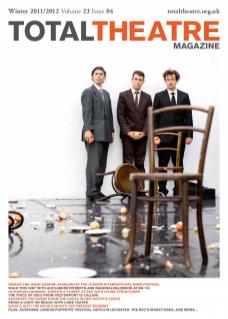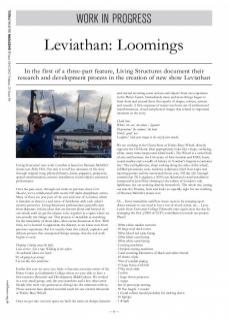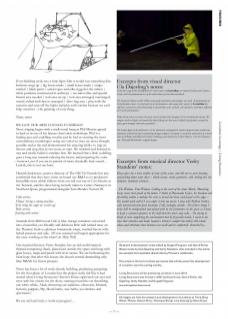Living Structures’ new work Leviathan is based on Herman Melville’s classic text Moby Dick. Our aim is to tell key moments of the story through original song, physical theatre, dance, puppetry, projection, spatial transformation, massive installation, found objects and aerial performance.
Over the past years, through our work on previous show Cart Macabre, we’ve collaborated with nearly 100 multi-disciplinary artists. Many of these are now part of the cast and crew of Leviathan, which is fantastic as there is a real sense of familiarity with each other’s creative processes. Living Structures performances generally start from disparate visions, ideas that are thrown about and brewed in our minds until we get the chance to be together in a space where we can actually test things out. This process is incredible as searching for the materiality of those ideas often seems disastrous at first. With time, we’ve learned to appreciate the disaster, as we know now from previous experience that it is exactly from this critical, explosive and delicate process that unexpected things emerge, that the real work begins to exist.
Draping. Cutting away the light.
Lina arrives. Sets a rope. Walking in the rafters.
An awkward silence over lunch
‘It’s all going to go wrong’
‘I do not like their prediction.’
Earlier this year we were very lucky to become associate artists of the Pinter Centre in Goldsmiths College where we were able to have a first intensive Research and Development (R&D) phase. We worked in a very small group, only the core members and a few other artist friends who were very generous in diving into the unknown with us. Those sessions have planted essential seeds for our current rehearsals at Trinity Buoy Wharf.
Once we got into our new space we built the main set design elements and started revisiting some actions and objects from our experience in the Pinter Centre. Immediately more and more things began to form from and around these first sparks of shapes, colours, actions and sounds. A first sequence of scenes was born out of architectural transformations, visual and physical images that related to important moments in the story.
Chalk lines.
White/ the sea/ the whale / hypnotic
Desperation/ the widows/ the hunt
Tribal/ grief/ loss
Laughter/ stick your tongue to the roof of your mouth.
We are working in the Chain Store at Trinity Buoy Wharf, directly opposite the O2 Dome (that appropriately looks like a huge, surfacing, white, many times harpooned whale back!). The Wharf is a varied hub of arts and business: the University of East London and ENO; boats, sound studios and a wealth of history in ‘London’s forgotten container city’. The red lighthouse, ships rocking along the sides of the wharf; cobbled pavements; rusty machine sculptures; thick boat ropes and mooring points and the renowned eleven year, 302 day old Artangel commission The Longplayer, a 1000 year durational sound installation composed by Jem Finer chiming in the rafters of London’s only lighthouse (we are working directly beneath it!). The whole site, jutting out into the Thames, feels and looks so superbly right for our retelling of Herman Melville’s classic text.
Ah… Some immediate cashflow issues seem to be creeping up in direct contrast to our need to buy a ton of wood, rostra, etc… Larry Lynch from University College Falmouth once again saves the day by arranging the first £1000 of UCF’s contribution towards our project. Phew!!
- 300m calico muslin curtains
- 49 large steel deck rostra
- 180m blood red satin lining
- 250m black satin lining
- 180m white satin lining
- 2 sewing machines
- 5 broken sewing machines
- 2 and counting kilometres of black and white thread
- 45 sheets of ply
- 70m of conduit piping
- 11 large boxes with lids
- 170m steel cable
- 2 cellos
- 1 large-throw projector
- 1 organ
- 6m of prototype netting
- 50 free bagels + toaster
- 1 found rubber mould probably for melting down
- 10 laptops
- 1 dongle
If set-building week was a time-lapse film it would run something like: Intricate stage up | big boxes made | small boxes made | ramps crafted | black paint | aerial ropes and silks rigged in the rafters | white podiums constructed in archways | tea and coffee and special biscuit area needed | tool area set up | tool area arranged, rearranged, sorted, tidied and then re-arranged | ditto bag area | play with the curtains and turn off the lights and play with torches because we can’t help ourselves | the painting of everything.
Then, news:
WE GOT OUR ARTS COUNCIL FUNDING!!!
Next: singing began with a multi-tonal bang as Phil Minton agreed to lead us in one of his famous feral choir workshops. Phil is a leading jazz and yodelling vocalist and he had us creating the most extraordinary soundscapes using our voices in ways we never thought possible and at the end demonstrated his amazing ability to sing (to choose and sing that is) two notes at once. We watched and listened in awe and totally failed to emulate him. We learned that a little yodelling goes a long way towards relaxing the larynx and preparing the voice – however, not if you are in pursuit of more classically bent sound… Luckily, this is not our bent.
Hamish Jenkinson, creative director of The Old Vic Tunnels has just confirmed that they have come on board our R&D as co-producers! Incredible news which follows from our sell-out run of Cart Macabre at the Tunnels, and the show being recently taken to Centro Niemeyer in Northern Spain, programmed alongside Sam Mendes’ Richard III.
Cello arrives.
Hiques’ fixing a sewing machine.
‘If we bring the angle in, it will sag.’
Beth arrives.
‘Jousting with cotton.’
Amanda from Driftwood Café (a blue storage container converted into a beautiful, eco-friendly and delicious little café tucked away on the Thames) feeds us glorious homemade soups, smoked bacon rolls, baked potatoes and cake. All very nautical and hugely appropriate for the crew working at the wharf on Moby Dick!
Our musical director, Verity Standen, has an old-world nauticalthemed composing shack, placed just outside the space and hung with glass buoys, maps and paved with river stones. We are harbouring the faint hope that after this luxury she doesn’t started demanding only blue M&Ms for future projects.
There has been a lot of work already building, producing, preparing for the first phase of Leviathan but the project really felt like it had started when Living Structures’ director Klaus captivated our cast and crew with his visions for the show, running round the set describing our white whale, Ahab, drowning our audience, obsession, Ishmael, hysteria, puppets, Pip, blood-baths, wax baths, sea shanties and spermaceti.
We are well and truly a ‘work in progress’…
Excerpts from visual director Ula Dajerling’s notes:
In the first stage of this development the visual aspects of Leviathan are inspired by Russian Constructivism, with the predominant use of the solid colours of red, white and black.
The historical reference of this 1920s avant-garde movement contextualises our work. Transformation of the performance space is a focal point of our performances and among other aspects in Leviathan the emphasis is placed on colour fluctuating in monochrome cycles of black, red and white, referring to different parts of the performances.
Proposed but not yet executed, the props consist of large forms hanging in nets resembling whale guts. We imagine dark red shapes surrounded by black fishing nets that can be shifted by performers around the space, giant triangles and circles, pyramids…
The human figure of the performers is to be obstructed, and geometric costume design becomes another manipulation of theatrical space manifesting through sculpture. Geometry is reached by moderation of existent items of clothing; embedded with wireless technolog y and inspired by Liubov Popova, Varvara Stepanova and Aleksandr Rodchenko’s original designs.
Excerpts from musical director Verity Standens’ notes:
Klaus gives me a loose outline of some of the scenes and tells me to start brewing and putting down some ideas – think visual, stark, geometric, cold, boiling hot, the elements, minimal, abstract…
…The Widows. Four Women. Calling at the start of the show. Black. Mourning heavy voices that speak of the future. I think of Diamanda Galas, her freedom and flexibility within a melody; her voice is lyrical but loose and frayed at the edges – this would work well if I can adapt it into my music. I play with Balkan broken calls layered into four-part harmony. Cold, unhappy sounds. All of these things I write will be manipulated and played with by the performers in the space so I need to keep a constant openness to the shift that the music may take... I’m trying to think of voice completing the environment that K physically builds. I want to use voice that stretches and bends beyond a listener’s comfort but which still retains echoes and structures that listeners can recall and be comforted/ disturbed by…
Research & development notes edited by Dugald Ferguson and Dani d’Emilia. Boxout notes by Una Dajerling and Verity Standens. Also included in the article are excerpts from assistant director Danny Prosser’s workbooks.
This article is the first of a three-part series that will document the development of Leviathan over the coming months.
Living Structures will be premiering Leviathan in June 2012. Living Structures was formed in 2007 by Klaus Kruse, Dani d’Emilia, Ula Dajerling, Verity Standen and Dugald Ferguson. www.livingstructures.co.uk


